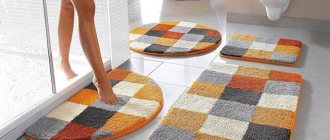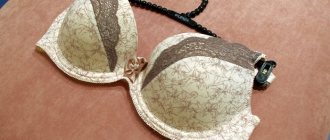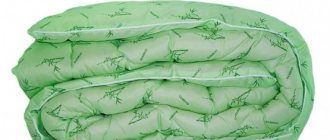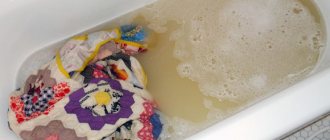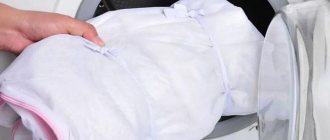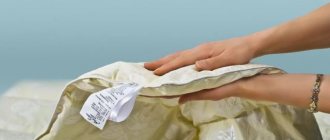A mattress cover is designed to protect it from various negative environmental factors. However, over time, the protective product itself inevitably becomes dirty and covered with various stains. Therefore, it must be cleaned periodically. To make this process as comfortable and efficient as possible, we will next look at how to wash a mattress cover so that it regains its original appearance.
Cotton
The mattress cover is made of 100% cotton, there are no synthetics, the fabric is only natural.
Such covers are bought for children and adults. Cotton mattress covers are easy to care for. How to wash waterproof mattress covers depends on whether there is a polyurethane membrane underneath or not.
Regular cases and waterproof cases are cleaned differently
Be sure to pay attention to this. For example, if cotton is both at the bottom and at the top - the temperature is 65 ° C, and if only at the top (there is moisture-repellent fabric at the bottom) - the temperature should be no more than 40 degrees
Proper care:
- Can be washed by hand or in a washing machine.
- Hot water will cause the fabric to shrink. Carefully set the temperature and make sure that during the entire procedure the knob is turned to 40 degrees, especially if there is a child in the house who likes to play around with the washing machine.
- The cotton may clump into small clumps. The problem is solvable. After washing, carefully straighten the filling.
- Ironing is not prohibited. On the contrary, this is welcome, since it also kills harmful microorganisms. Set the iron to the lowest setting and iron through slightly damp gauze.
- Detergents are selected according to the outer fabric. Cotton can be washed with delicates or baby powder.
Cotton mattress covers have a long service life. The shelf life of this product is measured by washes, the number of which is 100. This cover will last up to 3 years, then it will need to be replaced.
Can the mattress be washed?
Look for the answer to your question on the mattress label. Most likely, the manufacturer considers only dry cleaning acceptable. Do you want to take a risk? When starting to wet clean a mattress, be prepared to bear responsibility for any violation of care technology.
How to wash a Dormeo mattress
Washing Dormeo mattresses is prohibited. Liquid household detergents and ironing will cause irreparable harm to the materials used in the production of brand products. Home care includes regular cleaning with a regular vacuum cleaner.
How to wash a children's mattress
You can wash a foam mattress or one filled with holofiber (synthetic wool) in a bathtub or washing machine. Use a hypoallergenic liquid detergent for washing children's clothes. Repeated rinsing, gentle spinning, and flat drying are necessary.
How to wash a coconut mattress
Forums for parents describe options for washing a coconut mattress. It is suggested to remove and wash the mattress cover, and air the coconut filling on the balcony in the shade. Quite complicated and time-consuming, right?
What do we have to do:
- vacuum regularly;
- use a waterproof mattress cover;
- at least once every 2 years, take the mattress to the dry cleaner or call specialists from a specialized company to your home.
You can only wash the mattress cover, by hand or in the machine on a delicate cycle.
How to wash a spring mattress
Mattresses with dependent and independent spring blocks do not need to be washed. Vacuum cleaning, wet cleaning, hand or machine washing of the mattress cover - these are three options for amateur care of orthopedic spring mattresses. Be careful not to wet the litter. If the filling becomes moldy (except for the springs, there are several layers of insulation and textiles), then the mattress will be damaged.
How to wash a cotton mattress
You can wash a mattress with synthetic wool. This method is not suitable for cotton wool. Unless, of course, you are going to unstitch the mattress, wash the cover separately, and leave the cotton as is. However, the filler absorbs odors and absorbs all dirt, so washing the cover with dirty filler will not radically improve the situation.
Mattress with cotton wool
We do not recommend washing a mattress with natural cotton wool. Take a piece of cotton wool, wet it and dry it. You will see what happens to it, and you will understand that filling a cotton mattress after washing will never be the same. The cotton wool will form clumps and it will become unsuitable for sleeping.
Foam rubber
It is better to wash a mattress with foam filling by hand in the bathtub. Then you should rinse it thoroughly so that there is no detergent left in the pores of the foam rubber and you do not breathe in fumes from household chemicals. After rinsing, place the mattress upright in the bathtub against the wall to allow water to drain out of it. Dry it on the balcony or in the yard in the shade.
How to wash an orthopedic mattress
The markings on the orthopedic mattress say unequivocally - dry cleaning only. This means that the manufacturer does not recommend using any water-based technologies (solution, foam, steam) to care for the product. Only the replacement cover can be washed by machine or by hand. Use a liquid product without bleach.
Woolen
It is recommended to dry clean a mattress with a wool filling. Natural wool, in principle, cannot withstand contact with water, this applies to any product. If you nevertheless decide to wash a mattress with wool filling, then:
- the water temperature should not exceed 30 degrees C;
- use a mild hypoallergenic liquid detergent for delicate washing;
- Dry the washed item away from heat sources to avoid shrinkage.
Holofiber
Synthetic wool made from spiral-shaped hollow polyester fibers retains volume due to its structural features, does not wrinkle when washed, and does not bunch up. The mattress can be washed by hand or in a machine (depending on the drum capacity and product size).
Important terms:
- temperature up to 40 degrees C;
- wash in shampoo or gel for delicate textiles, which are easier to rinse than powder;
- push-ups without twisting;
- delicate ironing when the iron is heated to 100 degrees C.
IMPORTANT : read the label before washing. Perhaps the manufacturer indicated special conditions for caring for the fabric of the cover.
Getting rid of stains and dirt before the main wash
If there are stubborn stains on the mattress cover, they must be removed before completely washing the product. Let's figure out what you need to wash various stains with.
Blood
To remove blood stains from fabric, you need to treat them with a cool soapy solution. To do this, you need to moisten a soft sponge with liquid and actively rub the stains until they disappear. At the end of the hygiene procedure, rub the cleaned area with a cotton swab soaked in peroxide.
Urine
If urine stains have just appeared on your mattress cover, you can easily wash them off with clean cold water. If there are old puddles, you will need to do the following:
- wet the problem area, drop liquid soap on it, and rub a little;
- Treat the stain with lemon juice and a little salt on top;
- after which - apply nine percent table vinegar to the stained area;
- after five to seven minutes - remove any remaining dirt with a clean cloth soaked in water.
Cosmetics
Rubbing alcohol or nail polish remover will help remove traces of beauty products from the mattress cover. The method of application is simple. First, you need to moisten a cotton pad with the chosen product, then actively rub the problem area until the dirt disappears.
Wax
If wax accidentally gets on the mattress cover, do not wash the product immediately. First you will need to wait until the wax drops completely harden. Then, carefully scrape them off with the blunt side of a knife or nail scissors. At the end of the procedure, you need to iron the stained fabric through a paper kitchen towel. As a result, wax residues will transfer to it.
Fat
Any adsorbent will help deal with greasy stains. For example, starch, baking soda or crushed activated carbon tablets. To clean the fabric from which the mattress cover is made, it is necessary to pour the selected powder in a thick layer onto the stained area. After that, lightly rub the adsorbent particles into the stain. After thirty to forty minutes, you will need to remove any remaining detergent with a soft brush for cleaning clothes.
Sticky
If chewing gum or plasticine is stuck to the surface of the mattress cover, exposure to low temperatures can remove the contamination. To clean, you need to wrap the cover in a plastic bag and put it in the freezer for two to three hours. After this, the sticky residue can be carefully scraped off with a knife.
Red wine
To remove wine stains, you just need to sprinkle them generously with salt and rub a little. Baking soda can also be used for hygiene procedures.
Other stains
In a situation where there are stains of unknown origin on the product, you should treat them with a universal cleanser - freshly squeezed lemon juice. It contains organic acid, which carefully removes any contaminants.
As you can see, washing the mattress cover is not at all difficult. Using the useful recommendations described in this article, even an amateur in the field of cleaning can cope with such a task.
How to dry a mattress cover
In the complete absence of spinning in manual and automatic washing, the mattress cover remains completely saturated with moisture. It must be dried properly so that it does not dry out and become deformed. To do this, give it the most correct shape and place it completely on a horizontal surface. For quality drying, ensure good air circulation so that evaporated moisture does not linger in the room.
The best measures are preventative. If you don't let the cover get dirty, you won't have to wash it often. To do this, mattress covers are usually covered with bed linen on top, which serves as a barrier to major contaminants, including dust. Break the habit of eating or drinking in bed to prevent crumbs and liquids from getting on your bed linens.
The manufacturer of each product provides recommendations for caring for its product. It is usually enough to ventilate the mattress cover from Ascona and other manufacturers several times a year, periodically vacuum it and remove minor dirt.
Below is a video showing how to wash a mattress cover in a washing machine.
The mattress cover should be cleaned at least once every 3-6 months.
Can a waterproof or sheep wool mattress pad be washed, and if so, how?
The answer depends on what material the bedding is made of and what kind of filling is inside. After all, there are covers that, when in contact with water, lose their protective properties.
Before cleaning or washing a product, read the information on the label or instructions.
It is important to follow these instructions because the manufacturer has tested and tested so they know how the fabric will behave under certain conditions.
The upper trim is often made of cotton, microfiber, and bamboo.
Microfiber is one of the most durable fabrics. It can withstand temperatures up to 60 °C, and, if boiling is necessary, up to 95 °C. For washing, powder detergents can be used.
Mattress covers made from cotton fabrics are dangerous because they can shrink. Therefore, the optimal temperature for them is up to 40 °C. Washing can be either manual or machine. Bamboo fiber needs more gentle care. Textiles are washed at temperatures up to 40 °C, bleaches are not allowed in SMS, and machine drying is prohibited. Ironing such linen is prohibited.
The covers are cleaned at least once every 3-6 months, and in between they are cleaned with a vacuum cleaner, beaten out, and ventilated. Dry mattress covers in the fresh air, straightened out, in a horizontal position.
Preparation
If the mattress cover has not been cleaned for a long time, then it does not hurt to vacuum it before washing. It is convenient to do this without removing it from the mattress itself, so that it holds its shape and does not crumple under the brush. If you place the mattress on the floor, it will be much easier to vacuum it. A vacuum cleaner will remove cobwebs, dust and mites that live in it from the fabric. This will allow the washing powder to focus its energy on the main contamination during washing.
Preparing for washing
After cleaning with a vacuum cleaner, the cover is carefully removed from the mattress. Before you start washing, you need to study the manufacturer's label, which indicates the main modes. For some products, manual or automatic mode with all the necessary parameters is indicated.
Advice: if there is a symbol prohibiting automatic washing, then the mattress cover should only be washed by hand, otherwise there is a chance that it may be irreversibly damaged.
How to wash a mattress cover: basic rules
Despite the fact that the cover gets dirty much less often than bed linen, there are still nuances that need to be studied before starting the procedure.
It needs to be washed at least once a quarter (if the fabric has elastic bands) and at least once a year if the cover covers the mattress completely. This must be done even if there are no visible stains on the material. The fact is that after some time it absorbs dust particles, dead skin cells, animal hair, and sweat. They are not always visible to the eye, but there are still contaminants
Therefore, regular cleaning will be beneficial. Be sure to pay attention to the label sewn to the seam of the product, which indicates the temperature conditions, type of filler and type of fabric. Failure to comply with the specified conditions may damage the case irrevocably. If there is no label with information, you should choose the safest modes - “manual” or “delicate”. Before washing, it is recommended to carefully inspect the fabric for holes or broken locks.
If necessary, you must first eliminate all the shortcomings. You should choose stain removers that are suitable only for this material. The type of washing of a particular type of cover depends on its top layer and filling. Some of them can only be washed by hand (for example, with camel hair), others are recommended only for dry cleaning. These include mattress covers with coconut filling.
Manually
The manual process is suitable for the following types of cases:
- cotton;
- synthetic;
- microfiber;
- bamboo;
- padding polyester;
- from holofiber;
- membrane
Algorithm:
- Soak the product in warm water with the addition of powder or gel at the rate of 1 tablespoon of product per 5 liters.
- Leave for 15-60 minutes (depending on the degree of contamination and type of material).
- Lightly crush the cover and drain the liquid.
- Fill the basin again, add the product, lower the cloth and wash it with your hands;
- Rinse thoroughly, changing the water 3-4 times.
In an automatic car
The label on the product will tell you whether the mattress cover with a specific filling can be washed in the washing machine. Therefore, before starting the device, carefully read the instructions.
The automatic process is allowed for the following types of mattress covers:
- from padding polyester or holofiber;
- wool products (except camel);
- with down-feather filling;
- microfiber;
- cotton;
- mixed composition.
How to wash a mattress cover in a machine:
- If the contamination is severe, you should first soak the case in warm water with the addition of 20 ml of liquid or gel detergent. The duration of the procedure is no more than 15 minutes.
- After this, you need to drain the water from the container, squeeze the product a little and place it in the drum of the unit.
- Add detergent (20-30 ml) to the washing powder compartment.
- Select the most gentle mode - “manual” or “delicate”. Settings for wool items are also suitable.
- If possible, remove spinning and drying.
- Enable the Start button.
Dry cleaning
Some types of mattress pads do not tolerate moisture, so they are only allowed to clean stains without using water or using a minimal amount of it. These include cases filled with:
- buckwheat husk;
- seaweed;
- latex;
- polyurethane;
- coconut fiber.
The most accessible means for the “dry” method is soda. If you need to clean the entire surface, sift the powder through a sieve, leave for an hour, then use a vacuum cleaner to remove the grains. This method allows you to remove dust, dead skin particles, hair, harmful microorganisms and unpleasant odors.
To clean local contamination, you can use a universal remedy - borax. It is used in powder form, and therefore is not absorbed deeply into the fabric. To do this, apply the product to the stain, let it sit for an hour, then remove the residue with a brush.
How to remove different types of contaminants?
The choice of the optimal cleaning product depends on what exactly the mattress was stained with. For example, hydrogen peroxide helps get rid of blood or urine stains, and you can remove cosmetics using laundry soap.
Urine
Urine not only leaves behind stains, but also an odor that ingrains itself into the fabric and is difficult to remove. To deal with the problem, proceed as follows:
- Cover the surface of the stain with baking soda.
- In a separate container, dilute vinegar with 9% water, mixing the liquids in equal proportions.
- Pour the solution into a spray bottle and irrigate the contaminated area. This treatment will lead to the formation of foam; you need to wait until the reaction is completed.
- Soak a rag in the soapy solution and pass it over the surface of the mattress, then wipe it with a clean damp cloth to remove any remaining product.
After processing, the product is sent to dry in fresh air for at least 3 days. This article will tell you in more detail.
Blood
You can remove a blood stain from a mattress using ammonia. Algorithm of actions:
- open the windows to allow fresh air into the room, as ammonia has a pungent odor;
- dissolve ammonia with water in a ratio of 1:4;
- spray the composition using a spray bottle on the contaminated surface;
- leave for half an hour;
- soak a cotton pad in the solution, gradually removing the stain;
- Wipe the mattress with a dry cloth and leave to dry.
Ammonia should not be used by people suffering from bronchial asthma or respiratory failure. You can find out more here.
Cosmetics
Makeup stains can be easily removed with laundry soap. Mode of application:
- grate the soap into shavings, dissolve in warm water until a thick paste is obtained;
- apply it to the stain, whisk with an old toothbrush;
- leave for 15 minutes;
- Remove with a damp cloth and wait for the mattress to dry.
If necessary, the procedure can be repeated by adding a small amount of dishwashing detergent to the soap.
Ink
If the ink is fresh, you need to sprinkle it with starch or talcum powder, cover it with a paper napkin and press it with a press. After 12 hours, the powder is collected with a vacuum cleaner or swept away with a brush.
Old stains are treated with ethyl alcohol.
Procedure:
- Moisten a cotton pad with vodka.
- Use it to treat the problem area.
- Leave to act for 15 minutes.
- Collect remaining liquid with a dry cloth.
There is no need to rinse off the alcohol; it will evaporate on its own in a few hours.
Coffee and wine
Wine and coffee stains can be removed with citric acid.
Mode of application:
- Dissolve 1 tablespoon of citric acid in a glass of warm water.
- Apply it to the stain in any convenient way.
- Leave for half an hour.
- Use a cotton pad or a clean white rag soaked in lemon juice solution to wipe the contaminated area until the stain completely disappears.
- Treat the mattress with a clean, damp cloth.
- Leave to dry.
Yellow stains
Yellow stains can be removed with toothpaste. For processing, a composition without dyes and solid inclusions is used.
Mode of application:
- the paste is diluted with a small amount of warm water;
- distribute the composition over the stain and leave for 30 minutes;
- if the paste has frozen, moisten it with a damp sponge;
- Remove the cleaning agent with a damp cloth.
When the mattress dries, the streaks will disappear.
Washing depending on type
Another condition for high-quality and safe washing is to determine the degree of mattress hardness. This factor also affects the progress of the wash.
Soft
Washing will depend on the filler:
- If mattress covers are filled with holofiber, cotton wool or bamboo, then the product can be washed in a washing machine. After washing, bed linen can be lightly squeezed to remove excess water.
- If bamboo fiber is used as a filler, then it can only be washed at a temperature of 30-40 degrees, no more. It is advisable to eliminate spinning altogether. Do not use bleaches or stain removers.
Hard
Hard mattress covers can only withstand dry cleaning. They are difficult to wash and dry. Excess moisture damages the base. In addition, the product cannot be knocked out or compressed. It is best to clean with a vacuum cleaner and a soft brush.
Cleaning removable elements
The removable elements of the mattress include covers that protect the structure from contamination. They, like bed linen, get dirty from human body fluids and careless use. They are removed, washed or dry cleaned.
There are general rules for caring for mattress covers:
- regular vacuuming and fresh air ventilation;
- wash in water not warmer than 40 degrees C;
- refusal of detergents with aggressive components. Use gels for washing children's clothes.
The care technology depends on the material from which the mattress cover is made. Products made of latex, polyurethane foam, and coconut coir are subject to dry cleaning. Washing parameters depend on the textile from which the cover is made. The main materials are thick cotton, linen, jacquard, membrane fabric.
How to wash a mattress cover
Washing can be:
- amateur and professional;
- at the client’s premises or with removal to the workshop;
- manual and machine;
- with standard or eco-friendly detergent.
How to wash a waterproof mattress cover
These covers are made from high-tech membrane fabric. Its peculiarity is that it is waterproof, but at the same time it breathes and does not float. It is erased:
- only by hand, without friction. Machine washing and mechanical stress destroy the porous structure of textiles;
- without chlorine-containing detergents. The ideal option is a delicate wash gel;
- without boiling - the water temperature should not exceed 40 degrees;
- with plenty of rinsing to eliminate detergent residues in the pores.
Excess moisture is removed by gentle hand squeezing without twisting. To dry, you can lay the mattress cover on a cotton cloth away from direct sunlight. No need to dry it on a radiator or with a hairdryer. It is recommended to treat a clean mattress cover with a special impregnation to protect the porous structure. Aerosol packaging of the drug allows you to do this quickly and economically.
How to wash a jacquard mattress cover
A jacquard cover is characterized by a special pattern, woven or stitched. It can be made of natural cotton, linen, synthetics. Manufacturers do not recommend washing them. On all products you will read the labeling - dry cleaning only. Follow manufacturers' directions .
How to wash a child's mattress cover
Since the child does not always control the fulfillment of physiological needs, a protective layer or cover made of membrane material is often used on children's mattresses. It keeps secretions out and protects against stains and odors.
Removable membrane elements should be washed more often to free the pores from dirt. Hand wash, temperature not higher than 40 degrees C, liquid detergent without bleach or conditioner. The cover is allowed to drain without squeezing, and dried on a line - in a vertical position in a straightened state.
How to wash an Ikea mattress cover
The manufacturer writes on the labels - dry cleaning only. But Russians are not used to retreating, so on the Internet there are tips from those who washed the cover and were satisfied with the result. Experts from CLEAN EVERYTHING recommend following the manufacturer's instructions on the mattress label. But, if you are willing to take the risk, we offer an algorithm that, according to its author, gave an acceptable result:
- the cover was washed in summer in water at 25 degrees C to avoid shrinkage;
- the main detergent is laundry soap, and hydrogen peroxide was used to remove blood stains from the mattress (this article has a section on removing blood);
- washed with a soft brush or sponge;
- washed the mattress in the bathtub. A wet case weighs several kilograms. Washing requires a lot of physical effort and time;
- drying on a strong rope or crossbar. The floor under the mattress cover should be washed in case a wet item suddenly slips or the rope breaks.
How to wash an Ascona mattress cover
A characteristic feature of Ascona mattresses is the Protect a bed cover, which can withstand two hundred washes. It is recommended to wash it in a machine or by hand. Water temperatures are not higher than 50 degrees C.
How to wash a mattress cover
Look at the product label. Is it possible to wash by hand or by machine? If yes, wash the mattress cover yourself or invite specialists from a specialized company.
Can a mattress cover be washed in a washing machine?
Modern washing machines cope with washing thick double bed covers. Follow the manufacturer's care instructions on the label.
At what temperature should you wash a mattress cover?
We recommend washing mattress covers at temperatures up to 40 degrees C. It is better to add washing gel without bleach and other additives directly to the drum.
Features of washing products from some manufacturers
Each manufacturer has its own distinctive features that must be taken into account during the washing process.
"Ascona"
The outer layer of the mattress cover is made of cotton material. Caring for such fabric must be careful, otherwise the product will stretch and deform:
- Before washing, the machine is set to a mode that assumes a water heating temperature of 40 degrees.
- For washing use only mild detergents.
- You cannot set a spin program.
- You need to dry it on a flat surface, spreading an oilcloth under the wet product.
Waterproof mattress covers can withstand washing at 50 degrees. The shape and color are not lost even after numerous washes.
"Ormatek"
Jacquard satin is often used to sew a mattress cover. The material is strong and durable. With proper care, this material will retain its original appearance for a long time:
- Set to delicate wash mode. The water temperature is no more than 30 degrees.
- Spinning and drying the product in a machine is not allowed.
- For washing use only soft detergents.
- Do not use stain removers, bleaches or conditioners.
- There should be plenty of free space in the drum during washing.
- It needs to be dried in a horizontal position.
- It is permissible to iron bedding only from the wrong side.
"Ikea"
The IKEA store has the right mattress for every customer. The mattress cover protects the filling from contamination and extends the life of the mattress. Most products are made of cotton and polyester:
- Fabrics can be washed in a washing machine at 60 degrees.
- Do not use bleaches, stain removers, or conditioners.
- After washing and drying, do not iron.
Down-filled mattress covers
You can wash items filled with down in a washing machine if it can withstand more than 7 kg of laundry. The delicate wash mode is set to medium speed. Liquid powder should be used, and the use of bleaches is strictly prohibited.
Important! Urine stains can be removed with salt mixed with lemon juice. The mixture must be spread on the stain and left for 2-3 hours, then washed off with a sponge. You can also use laundry soap and dry powder.
Foam mattress
Some buyers, preferring cheap goods from Ikea, purchase foam mattresses. This material accumulates dust very well, absorbs odors and moisture. To keep the product clean, it is recommended to periodically wash the Askon children's mattress filled with foam rubber. You can do this manually. After removing the mattress cover, soak the product in warm soapy water. Carefully passing over the surface with a brush, we clean the foam rubber from stains.
Foam mattress
The next step is rinsing. Since the filler perfectly absorbs water and soap, you need to rinse the product as thoroughly as possible. It is recommended to rinse a children's mattress in warm water, changing it 5-7 times until the foam completely disappears
Then it is equally important to dry the mattress thoroughly so that no moisture remains inside
Washing a mattress without stitching
Most mattress manufacturers explicitly state on their labels that they are dry clean only. Wetting the multi-layer structure of a spring mattress means ruining it. Dampness inside the filler is unacceptable. Even a cotton mattress with synthetic filling requires high-quality drying near a radiator or outside in the summer. You can wash it without embroidering it. For this:
- place the mattress in a bathtub filled with cleaning solution for 20 minutes to soak;
- drain the dirty solution;
- pour a new portion of soapy water, remember the mattress well with your hands;
- rinse repeatedly, changing the water until it becomes clear and clean;
- figure out how to let the water drain into the bathtub;
- dry.
Recommendations for washing a mattress cover
Mattress covers should be washed 3-4 times a year, vacuumed and ventilated monthly, and dirt should be removed from them as soon as possible. You need to read the manufacturer's recommendations, carefully select washing products and dry the product well: not only the cover, but also the mattress and bed linen become moldy. How to wash a mattress cover without ruining it?
Choosing a detergent
To wash mattress covers, do not use washing powder, chlorine-containing products and oxygen bleaches, which “clog” the pores of the membrane fabric. These products need to be washed with special gels for the membrane: “DOMAL Sport Fein Fashion”, “Nikwax Tech Wash or Perwoll”, etc., but when washing by hand, you can also use shavings of laundry soap. The main thing is to rinse the item well.
Simple stains can be removed with soap. Difficult stains can be removed using the following methods:
- Fat. Sprinkle the stain with soda, talc or starch, let it absorb the grease and clean it with a soft brush. Next, blot the residue with soapy water and wash the item. Stubborn stains are removed using turpentine or gasoline, which is moistened with a cotton pad, but before that you need to test the liquid on an inconspicuous area of the material.
- Mold. You need to dry the item, and then treat the moldy area with a solution of vinegar or alcohol. If there is a lot of mold and it has become deeply embedded in the fabric, it is better to throw away the product.
- Blood. You need to blot the stain with a dry cloth as quickly as possible, and remove the residue with the same blotting movements using a solution of laundry soap and hydrogen peroxide. You need to blot rather than rub the stain so that streaks do not form.
- Vomiting and urine. To prepare the stain remover, dissolve 1 tbsp in 1 liter of warm water. l. transparent dishwashing gel and 0.5 cups of soda. You need to apply the product to the dirt with a sponge, sprinkle it generously with soda, leave for several hours and clean with a soft brush. This composition eliminates not only stains, but also unpleasant odors.
Wash, rinse and spin mode
Before washing your waterproof mattress cover, you should vacuum or beat it to remove any dust. In the washing machine, select the delicate mode and set the water temperature to about 30–40°C.
The main thing in washing membrane products is the absence of strong mechanical stress and thorough rinsing, so after washing they are lightly wrung out by hand. These items must be washed separately from other items.
If you intend to wash mattress covers by hand, you need to remember that after getting wet they become very heavy and difficult to wring out, so covers for children's and other small mattresses are mainly washed this way. To do this you need:
- fill a container with water at a temperature of 30–40°C and dilute a little detergent in it;
- place the mattress cover in a soapy solution and wash it with blotting movements or soak it for 7-10 minutes;
- rinse it until the water runs clear;
- Gently wring out the product, blot it with a napkin and put it away to dry.
How to dry the product?
A membrane mattress cover cannot be twisted, so after washing, lightly wring it out with your hands and hang it over a container so that the water drains from it. Next, you need to straighten it and put it in a well-ventilated place to dry. The product is dried in a horizontal position away from sunlight and heating devices. You should not leave the cover in the cold, which, like high temperatures, destroys the membrane.
It is not recommended to iron a waterproof mattress cover: to avoid creases, you need to carefully smooth out the folds on the damp material.
To maintain water-repellent properties, it is recommended to periodically treat membrane mattress covers with impregnations. Gradually, the protective layer applied by the manufacturer wears off, and the mattress cover begins to allow moisture to pass through. You can wash it with membrane fabric gel or use special sprays. Items must be processed after washing to remove all dirt.
How often do you need to wash?
With constant use, any thing becomes dirty. Even if a person often changes bed linen, dust, skin particles, and dirt accumulate in the mattress cover. Fabric that is constantly in contact with a sleeping person must be shaken out and ventilated every month. To get rid of excess dust, you can use a vacuum cleaner. It is worth carrying out general cleaning once a season, taking into account the material and the manufacturer’s recommendations, which are indicated on the tag. To make an expensive product last longer, you shouldn’t wash it more often. With proper care, it will remain water-repellent after the hundredth wash.
How to properly wash mattress covers made of different materials
The top layer of mattress covers can be made from a variety of natural and synthetic materials. Therefore, washing rules can vary greatly.
How to wash a cotton mattress cover
It is easiest to care for a product made from natural cotton; this material tolerates machine washing very well:
- If the cover is made exclusively of cotton fabric, it can be washed even at temperatures above 60 °C. But if there is a waterproof synthetic membrane underneath, then water should still be used no hotter than 40 °C.
- The mode is also set depending on the characteristics of the product. For a waterproof item you should use a delicate wash, an all cotton mattress cover can be washed on a heavy setting.
- It is recommended to use liquid detergent. Cotton fabric does not suffer from the effects of the powder, but its smallest particles can still remain inside the product and lead to the development of allergies.
The pure cotton mattress cover can be washed even at 60°C
You still cannot wring out a cotton item after washing; the water should simply drain off. But you can iron it in the absence of a waterproof layer; ironing will help destroy any microorganisms.
How to wash a wool mattress cover
For a wool cover, machine washing is not prohibited, but is not recommended. It is better to wash the mattress cover by hand:
- at maximum 30 °C;
- without squeezing;
- with a special detergent for wool, which contains lanolin.
Machine washable for a wool mattress cover only without spinning and in cold water
If for some reason it is impossible to wash the item by hand, you must set the machine to the most gentle mode. The spin should be turned off completely so that the item does not become deformed; the water temperature should be selected as low as possible. If there is a sudden temperature change during the transition from washing to rinsing, the wool may shrink.
How to wash a bamboo mattress cover
Soft yet durable bamboo fiber is machine washable. You need to wash a bamboo mattress cover according to the following rules:
- in delicate mode, in water not hotter than 40 ° C;
- using a soft washing gel;
- without spinning or with a minimum number of revolutions.
A mattress cover made of bamboo fabric can be loaded into an automatic machine on the delicate mode
You cannot dry a bamboo mattress cover in automatic mode or iron it after washing.
How to wash a mattress cover with down filling
Down products are popular because of their softness; they are often purchased for hard orthopedic mattresses to make sleeping more comfortable. But washing is associated with certain difficulties:
- Down filling often clumps into clumps when washed. It is best to wash a down product by hand, in which case the mechanical impact is minimal and the cover retains its shape well.
- If you cannot wash the item by hand, then you need to use the most gentle washing mode in the machine. The maximum temperature for washing down is 30 °C; the spin cycle must be turned off completely.
- Along with the down cover, you should put special balls in the machine; during the washing process, they will whip up the filler and prevent it from clumping together.
- It is best to wash a down filled case using liquid soap. Cleaning products are very difficult to wash out of down, so it is recommended to avoid even special gels.
It is advisable to wash the down mattress cover by hand so that the down does not get lost
Attention! When wet, a down product becomes very heavy, so it can only be processed in a machine if the maximum load exceeds 5-7 kg. Otherwise, household appliances may break.
How to wash a mattress cover with coconut filling
Coconut flakes have good orthopedic properties and retain their shape well. But that is why such covers are prohibited from being washed either in a machine or by hand.
If a stain appears on the cover, you need to moisten the stained area and wipe off the stain with a soap solution. Twice a year you can wipe the surface of the product with a damp sponge, being careful not to wet it too much. You cannot completely immerse the case in water; this will quickly render the filler unusable, and the only thing left to do is throw it away.
A mattress pad filled with coconut cannot be washed; it must only be carefully treated with a damp sponge.
Features of caring for mattress covers from this manufacturer
Depending on the material from which the mattress cover is made, the rules for caring for it differ.
If machine washing is allowed, it should be gentle, allowing you to maintain the functionality of an expensive product.
With polyester fibers
The mattress cover filled with polyester fibers is machine washable. This product is not picky in care, so it does not require compliance with any strict rules.
Basic recommendations:
- wash in water up to 60 degrees;
- spin at speeds up to 600 rpm;
- refusal of aggressive detergents;
- dry on a flat surface.
If the cover is orthopedic, contains other fillers in addition to polyester fibers and has a rigid frame, it cannot be washed by hand or in a machine. For such products only dry cleaning is suitable.
With coconut filling
A mattress cover with coconut coir is characterized by increased rigidity, allowing you to make your sleeping place not only comfortable, but also correct from an anatomical point of view.
It cannot be washed by machine or by hand, as this will lead to loss of functionality of the product.
However, the manufacturer foresaw possible difficulties with cleaning and provided the mattress cover with a removable knitted cover. It closes with a zipper. It can be washed both in a machine and by hand.
Basic Rules:
- Do not exceed the water temperature of 60 degrees.
- Do not squeeze the product at high speeds, so as not to provoke its shrinkage.
- Do not dry on a radiator or in the sun.
It is not difficult to take care of the “filling” of the mattress cover. It is enough to ventilate the product 1-2 times a month and vacuum it with each change of bed linen.
Latex and holofiber
A product made of natural latex filler and a knitted cover allows you to give elasticity to the mattress, make the sleeping area soft and comfortable, and eliminate unevenness.
The manufacturer recommends regularly ventilating it in a room with dry and cool air. If this is not possible, then it is taken out onto the balcony or onto the street.
This procedure must be performed at least once a month. To get rid of stubborn stains, you can use a washing machine.
Procedure:
- load the product into the drum;
- set the “delicate wash” program;
- set the water temperature to 40 degrees;
- spin is turned off;
- After completing the cycle, allow the water to drain, lay the cover on a flat surface and wait until it is completely dry.
Care for a holofiber mattress cover in the same way. If necessary, the washing temperature is increased to 60 degrees. You can use the automatic spin function at 400 rpm.
Both regular washing powder and gel are used as a detergent. The main thing is that they do not contain aggressive components (bleaches, chlorine, acids).
The mattress cover is protected from direct sunlight. They may cause damage to the product.
Waterproof
It is recommended to wash the waterproof mattress cover by hand in cool water, or in a machine on a delicate cycle.
Rules to follow:
- Do not exceed the temperature of 30 degrees.
- Do not turn on the spin function or twist the product by hand.
- Use liquid detergents that do not contain chlorine or other bleaching ingredients for washing.
For minor contamination, local treatment of the product with a sponge and soap solution is sufficient. Waterproof covers should not be dried near heat sources or in the sun. They are not allowed to be ironed.
Cleaning covers made from other materials
When sewing mattress covers, various fabrics can be used
A wide variety of materials and fabrics are used in the production of mattress covers. By determining their composition, you can choose an effective cleaning method and optimal washing conditions that will preserve their structure and characteristics.
To understand how to wash a mattress cover, let’s highlight the most common types of materials used in their manufacture:
- Sheep and camel wool. Woolen products are susceptible to dust accumulation; the fabric quickly absorbs various liquid substances. Fresh stains and traces of dirt are removed using a sponge and wool stain remover diluted with water at a temperature of about +30°. This temperature value should be observed when washing by hand or machine. To process in a washing machine, you need to select the mode for woolen items. It is not recommended to unscrew the mattress cover; you need to lightly squeeze it on both sides. The detergents used must contain lanolin.
- Feather and down materials. Such items can be washed in a machine, provided that the centrifuge is designed for items of large volume and weight. To process the material, you need a mode with gentle parameters and a spin of medium or low intensity. Liquid detergents are recommended; bleaches and conditioners should not be used.
- Covers filled with coconut, latex or polyurethane. Washing such materials should be avoided, since their properties are lost under the influence of water, temperature and mechanical stress. The filler should be removed from the mattress cover, shake out the dust and dry thoroughly. Only the cover can be washed.
- Holofiber. This synthetic hollow material is able to withstand high temperatures during washing, exposure to various washing and cleaning agents with aggressive substances, and significant loads during machine washing and spinning. Almost any processing parameters are suitable for it, so when choosing washing conditions you need to focus on the least durable material combined with holofiber.
- Knitted fabric. This material can stretch. To wash it, use a gentle, delicate cycle with neutral detergent compositions in the form of a gel. Such products should be dried in a horizontal position.
- Jacquard-satin. In order not to damage the mattress cover made of such fabric, the centrifuge of the machine should be filled only to half its volume. Processing parameters should be gentle, with water at +30°, without spinning, drying or using bleaches, conditioners, or stain removers. You can iron such fabric only from the wrong side at the minimum iron temperature.
It should be remembered that when washing mattress covers made of combined materials, it is necessary to select parameters and modes that are optimal for the most vulnerable fabrics. Depending on the degree of soiling, it is recommended to wash mattress covers 2-4 times a year. At the same time, they must be vacuumed, shaken out and ventilated monthly.
How to choose the right mattress cover?
Moscow stores offer a wide selection of different types of mattress covers. When deciding which mattress cover to choose, you usually focus on the following criteria:
- Purpose. A cover for a child's or double adult bed, for a sofa or for an elderly person, orthopedic, corrective or classic thin - you need to decide on the type of mattress cover before purchasing.
- Size. The dimensions of the cover must exactly match the mattress: too large will not fit securely, too small will not cover the entire surface or will not stretch. It is important to accurately measure the length, width and height of your sleeping area before purchasing a mattress topper.
- Quality. Experts recommend buying models only from well-known and trusted manufacturers. As a rule, large companies use only certified materials and carefully control their products. In this case, you can count on the safety and high level of performance of each product.
When choosing a mattress topper, it can be difficult due to the variety of composition and options. In this case, you should contact a store consultant who will help you choose a case model that suits all parameters.
Recommendations for use
Having understood the question of how to wash a mattress, you need to familiarize yourself with the rules for using the products.
- Orthopedic products with coconut filling should not be placed on a sagging surface.
- Children should not be allowed to jump on the mattress.
- You need to put a waterproof mattress cover on your child's mattress.
- To keep the orthopedic product clean, periodically vacuum the surface.
- A coconut mattress should be professionally cleaned once every 3-4 years.
- The removable cover can be washed once every 2-3 months.
Clean mattress
Thus
When purchasing an Ascon mattress from Ikea, do not forget to ask the seller how to properly care for the product. Not every mattress is washable. Orthopedic products with springs or coconut filling should not be washed or wet at all. To keep such mattresses clean, you need to purchase a waterproof cover that needs to be washed periodically.
What types of cover fastenings are there?
Another criterion for choosing a mattress cover is the way it is fixed to the surface of the bedding. There are three popular mounting options:
- Elastic bands at the corners. A wide elastic band sewn into the corners of this cover allows you to quickly attach it to the mattress and also easily remove it if necessary. The advantages of mattress covers with elastic bands include their low price. The main disadvantages are unprotected sides and the ability of the elastic bands to stretch over time, which leads to weak fixation of the product.
- Elastic band around the perimeter. This mattress cover is a cover that completely hides the sides and top plane of the mattress. A higher level of protection, reliable fixation and the ability to slightly adjust the size make it the best option for children and the elderly, when the cover is regularly washed.
- Lightning. Protective covers for mattresses with zippers may have a higher cost, which is due to the high reliability and comfortable operation of the product. Such models are tightly pulled onto the mattress, do not bunch up or slip, but require some effort when removing and putting them on.
Features of washing Askona mattress covers
A distinctive feature of Askona mattress covers is that in the manufacture of the outer layer, knitted cotton fabric is used, which requires special washing conditions, since otherwise it can stretch.
You should set the temperature no higher than 40 degrees, set the gentle mode, use only mild detergents, without twisting by hand and without spinning in the machine.
Such mattress covers should be dried on a flat surface, laid out on oilcloth; hanging them on a clothesline is contraindicated.
The waterproof mattress cover produced by this company differs from conventional membrane products in its temperature resistance and wear resistance.
It is designed for 200 washes and can withstand temperatures up to 50 degrees, as well as medium-heat machine drying.
With holofiber
Holofiber is an artificial hollow fabric that is used in outerwear and for sewing bedding, including mattress covers. When choosing a temperature regime, you should focus on the material to which the insulation is connected. Its fibers withstand high temperatures and do not collapse or “run away”. The maximum spin mode is also possible, since the filler does not change shape and does not bunch up. Also, artificial fiber is not sensitive to stain removers, solvents, and detergents.
And here we looked in detail at how to wash holofiber blankets and pillows.
What if the mattress cover cannot be washed?
You must purchase a dry cleaning kit. After removing the dirt using the stain remover from the kit, the mattress cover and scented sheets are placed in a bag and dried in the machine in a delicate mode at minimum speed. Water, air conditioner and other substances with which the sheets are impregnated evaporate and refresh the material. Next, you need to smooth out the cover with your hands and put it away to dry. Home dry cleaning is suitable for both periodically cleaning the cover from dust (2–4 times a year) and for removing minor dirt.
How to clean a mattress pad
There are some materials that should never be washed. These include:
- polyurethane;
- latex;
- coconut filler;
- buckwheat husk;
- seaweed;
- material with a “memory effect”.
In such mattress covers, only the upper fabric cover can be cleaned using the dry method.
At home
You can use a vacuum cleaner to dry clean the cover from dust and small debris. Twice a year the mattress cover must be ventilated outdoors or in well-ventilated areas. This will protect the product from unpleasant odors and dust mites.
